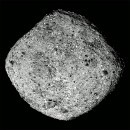As you’re reading this, a spacecraft with a complicated name is hurtling through space on its way back home, bringing with it a piece of an asteroid for us humans to study in the relative peace and quiet of our own home. After it arrives, it won’t end its mission, but head out once more to peak at a potentially more dangerous piece of floating rock.
The spacecraft is called Origins, Spectral Interpretation, Resource Identification, Security-Regolith Explorer, or OSIRIS-REx, for short. It launched in 2016, headed for asteroid Bennu, and spent three years working on stealing a piece of it.
In 2021, OSIRIS began its journey home, carrying with it 60 grams or so of regolith from the asteroid, which should be delivered to Earth sometime in 2023. The samples are to be brought down to Earth by means of a special capsule, while the spacecraft that carried it was supposed to stay in orbit after it reached Earth. But that’s no longer the case.
This week, NASA and the University of Arizona, which lead the OSIRIS-REx mission, announced the spacecraft would be sent out into the depths of space once more, this time hunting a potentially much more dangerous asteroid than Bennu: Apophis.
Officially dubbed 99942 Apophis, partially after the Egyptian deity that was the enemy of the Sun God Ra, the asteroid is estimated to have a size of 1,100 feet (340 meters), and, for all intents and purposes, seems to be the one that threatens our planet the most.
Discovered in 2004 by a team from the Kitt Peak National Observatory (KPNO), Apophis will make scary-close flybys of our planet in 2029, 2036, and 2068. How close? Math shows it could do so at a distance that is closer than some present-day geosynchronous satellites, 20,000 miles (32,000 km) from the planetary surface, being visible from the Eastern Hemisphere (Europe and Africa) with the naked eye.
Ever since 2019, there has been talk of making a spacecraft and sending it out to take a closer look at Apophis, but now that this asteroid-poking spacecraft will be reused, there’s no need to wonder what happened with that idea.
The reconfigured mission of the NASA spacecraft will be called OSIRIS-APEX, which stands for OSIRIS-Apophis Explorer, and will depart 30 days after the Bennu samples are delivered.
This time, it will not steal a piece of the asteroid, but study it for no less than 18 months, including actively. That means the spacecraft will approach the asteroid’s surface and fire its thrusters in a bid to understand what covers the piece of rock.
In 2021, OSIRIS began its journey home, carrying with it 60 grams or so of regolith from the asteroid, which should be delivered to Earth sometime in 2023. The samples are to be brought down to Earth by means of a special capsule, while the spacecraft that carried it was supposed to stay in orbit after it reached Earth. But that’s no longer the case.
This week, NASA and the University of Arizona, which lead the OSIRIS-REx mission, announced the spacecraft would be sent out into the depths of space once more, this time hunting a potentially much more dangerous asteroid than Bennu: Apophis.
Officially dubbed 99942 Apophis, partially after the Egyptian deity that was the enemy of the Sun God Ra, the asteroid is estimated to have a size of 1,100 feet (340 meters), and, for all intents and purposes, seems to be the one that threatens our planet the most.
Discovered in 2004 by a team from the Kitt Peak National Observatory (KPNO), Apophis will make scary-close flybys of our planet in 2029, 2036, and 2068. How close? Math shows it could do so at a distance that is closer than some present-day geosynchronous satellites, 20,000 miles (32,000 km) from the planetary surface, being visible from the Eastern Hemisphere (Europe and Africa) with the naked eye.
Ever since 2019, there has been talk of making a spacecraft and sending it out to take a closer look at Apophis, but now that this asteroid-poking spacecraft will be reused, there’s no need to wonder what happened with that idea.
The reconfigured mission of the NASA spacecraft will be called OSIRIS-APEX, which stands for OSIRIS-Apophis Explorer, and will depart 30 days after the Bennu samples are delivered.
This time, it will not steal a piece of the asteroid, but study it for no less than 18 months, including actively. That means the spacecraft will approach the asteroid’s surface and fire its thrusters in a bid to understand what covers the piece of rock.










